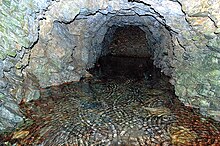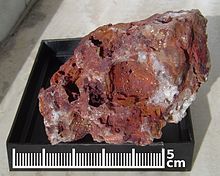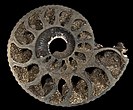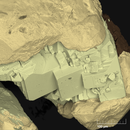Pyrite
| Pyrite | ||
|---|---|---|
Specific gravity 4.95–5.10 | | |
| Density | 4.8–5 g/cm3 | |
| Fusibility | 2.5–3 to a magnetic globule | |
| Solubility | Insoluble in water | |
| Other characteristics | paramagnetic | |
| References | [2][3][4][5] | |
The mineral pyrite (/ˈpaɪraɪt/ PY-ryte),[6] or iron pyrite, also known as fool's gold, is an iron sulfide with the chemical formula FeS2 (iron (II) disulfide). Pyrite is the most abundant sulfide mineral.[7]
Pyrite's metallic luster and pale brass-yellow hue give it a superficial resemblance to gold, hence the well-known nickname of fool's gold. The color has also led to the nicknames brass, brazzle, and brazil, primarily used to refer to pyrite found in coal.[8][9]
The name pyrite is derived from the Greek πυρίτης λίθος (pyritēs lithos), 'stone or mineral which strikes fire',[10] in turn from πῦρ (pyr), 'fire'.[11] In ancient Roman times, this name was applied to several types of stone that would create sparks when struck against steel; Pliny the Elder described one of them as being brassy, almost certainly a reference to what is now called pyrite.[12]
By Georgius Agricola's time, c. 1550, the term had become a generic term for all of the sulfide minerals.[13]

Pyrite is usually found associated with other sulfides or
Uses

Pyrite enjoyed brief popularity in the 16th and 17th centuries as a source of ignition in early firearms, most notably the wheellock, where a sample of pyrite was placed against a circular file to strike the sparks needed to fire the gun.[16]
Pyrite is used with
Pyrite has been used since classical times to manufacture copperas (ferrous sulfate). Iron pyrite was heaped up and allowed to weather (an example of an early form of heap leaching). The acidic runoff from the heap was then boiled with iron to produce iron sulfate. In the 15th century, new methods of such leaching began to replace the burning of sulfur as a source of sulfuric acid. By the 19th century, it had become the dominant method.[18]
Pyrite remains in commercial use for the production of sulfur dioxide, for use in such applications as the paper industry, and in the manufacture of sulfuric acid. Thermal decomposition of pyrite into FeS (iron(II) sulfide) and elemental sulfur starts at 540 °C (1,004 °F); at around 700 °C (1,292 °F), pS2 is about 1 atm.[19]
A newer commercial use for pyrite is as the cathode material in Energizer brand non-rechargeable lithium metal batteries.[20]
Pyrite is a
During the early years of the 20th century, pyrite was used as a
Pyrite has been proposed as an abundant, non-toxic, inexpensive material in low-cost
Pyrite is used to make
In value terms, China ($47 million) constitutes the largest market for imported unroasted iron pyrites worldwide, making up 65% of global imports. China is also the fastest growing in terms of the unroasted iron pyrites imports, with a CAGR of +27.8% from 2007 to 2016.[29]
Research
In July 2020 scientists reported that they have observed a voltage-induced transformation of normally
Researchers at Trinity College Dublin, Ireland have demonstrated that FeS2 can be exfoliated into few-layers just like other two-dimensional layered materials such as graphene by a simple liquid-phase exfoliation route. This is the first study to demonstrate the production of non-layered 2D-platelets from 3D bulk FeS2. Furthermore, they have used these 2D-platelets with 20% single walled carbon-nanotube as an anode material in lithium-ion batteries, reaching a capacity of 1000 mAh/g close to the theoretical capacity of FeS2.[32]
In 2021, a natural pyrite stone has been crushed and pre-treated followed by liquid-phase exfoliation into two-dimensional nanosheets, which has shown capacities of 1200 mAh/g as an anode in lithium-ion batteries.[33]
Formal oxidation states for pyrite, marcasite, molybdenite and arsenopyrite
From the perspective of classical inorganic chemistry, which assigns formal oxidation states to each atom, pyrite and marcasite are probably best described as Fe2+[S2]2−. This formalism recognizes that the sulfur atoms in pyrite occur in pairs with clear S–S bonds. These persulfide [–S–S–] units can be viewed as derived from hydrogen disulfide, H2S2. Thus pyrite would be more descriptively called iron persulfide, not iron disulfide. In contrast, molybdenite, MoS2, features isolated sulfide S2− centers and the oxidation state of molybdenum is Mo4+. The mineral arsenopyrite has the formula FeAsS. Whereas pyrite has [S2]2– units, arsenopyrite has [AsS]3– units, formally derived from deprotonation of arsenothiol (H2AsSH). Analysis of classical oxidation states would recommend the description of arsenopyrite as Fe3+[AsS]3−.[34]
Crystallography

Iron-pyrite FeS2 represents the prototype compound of the
The Fe atoms are bonded to six S atoms, giving a distorted octahedron. The material is a
The sulfur centers occur in pairs, described as S22−.[39] Reduction of pyrite with potassium gives potassium dithioferrate, KFeS2. This material features ferric ions and isolated sulfide (S2-) centers.
The S atoms are tetrahedral, being bonded to three Fe centers and one other S atom. The site symmetry at Fe and S positions is accounted for by point symmetry groups C3i and C3, respectively. The missing center of inversion at S lattice sites has important consequences for the crystallographic and physical properties of iron pyrite. These consequences derive from the crystal electric field active at the sulfur lattice site, which causes a polarization of S ions in the pyrite lattice.[40] The polarisation can be calculated on the basis of higher-order Madelung constants and has to be included in the calculation of the lattice energy by using a generalised Born–Haber cycle. This reflects the fact that the covalent bond in the sulfur pair is inadequately accounted for by a strictly ionic treatment.[41]
Arsenopyrite has a related structure with heteroatomic As–S pairs rather than S-S pairs. Marcasite also possesses homoatomic anion pairs, but the arrangement of the metal and diatomic anions differ from that of pyrite. Despite its name, chalcopyrite (CuFeS
2) does not contain dianion pairs, but single S2− sulfide anions.
Crystal habit
Pyrite usually forms cuboid crystals, sometimes forming in close association to form raspberry-shaped masses called framboids. However, under certain circumstances, it can form anastomosing filaments or T-shaped crystals.[42] Pyrite can also form shapes almost the same as a regular dodecahedron, known as pyritohedra, and this suggests an explanation for the artificial geometrical models found in Europe as early as the 5th century BC.[43][clarification needed]
Varieties
Cattierite (CoS2), vaesite (NiS2) and hauerite (MnS2), as well as sperrylite (PtAs2) are similar in their structure and belong also to the pyrite group.
Bravoite is a nickel-cobalt bearing variety of pyrite, with > 50% substitution of Ni2+ for Fe2+ within pyrite. Bravoite is not a formally recognised mineral, and is named after the Peruvian scientist Jose J. Bravo (1874–1928).[44]
Distinguishing similar minerals
Pyrite is distinguishable from native gold by its hardness, brittleness and crystal form. Pyrite fractures are very uneven, sometimes conchoidal because it does not cleave along a preferential plane. Native gold nuggets, or glitters, do not break but deform in a ductile way. Pyrite is brittle, gold is malleable.
Natural gold tends to be
Hazards

Iron pyrite is unstable when exposed to the
Pyrite oxidation and acid mine drainage
Pyrite oxidation by atmospheric O2 in the presence of moisture (H2O) initially produces ferrous ions (Fe2+
) and sulfuric acid which dissociates into sulfate ions and protons, leading to acid mine drainage (AMD). An example of acid rock drainage caused by pyrite is the 2015 Gold King Mine waste water spill.
- .[46]
Dust explosions
Pyrite oxidation is sufficiently
In modern coal mines,
Weakened building materials
Building stone containing pyrite tends to stain brown as pyrite oxidizes. This problem appears to be significantly worse if any
Occurrence
Pyrite is the most common of sulfide minerals and is widespread in igneous, metamorphic, and sedimentary rocks. It is a common accessory mineral in igneous rocks, where it also occasionally occurs as larger masses arising from an
Pyrite occurs both as a primary mineral, present in the original sediments, and as a secondary mineral, deposited during
Notable deposits are found as lenticular masses in Virginia, U.S., and in smaller quantities in many other locations. Large deposits are mined at Rio Tinto in Spain and elsewhere in the Iberian Peninsula.[60]
Cultural beliefs
In the beliefs of the Thai people (especially the southerner), pyrite is known as Khao tok Phra Ruang, Khao khon bat Phra Ruang (ข้าวตอกพระร่วง, ข้าวก้นบาตรพระร่วง) or Phet na tang, Hin na tang (เพชรหน้าทั่ง, หินหน้าทั่ง). It is believed to be a sacred item that has the power to prevent evil, black magic or demons.[61][62]
Images
-
As aammonitefrom France
-
Pyrite from Ampliación a Victoria Mine, Navajún, La Rioja, Spain
-
Pyrite from the Sweet Home Mine, with golden striated cubes intergrown with minor tetrahedrite, on a bed of transparent quartz needles
-
Radiating form of pyrite
-
Paraspirifer bownockeri in pyrite
-
Pink fluorite perched between pyrite on one side and metallic galena on the other side
-
SEM image of intergrowth of pyrite cuboctahedral crystals (yellow) and pyrrhotite (pinkish yellow)
See also
References
- S2CID 235729616.
- ^ ISBN 978-0-471-80580-9.
- ^ "Pyrite". Webmineral.com. Retrieved 2011-05-25.
- ^ "Pyrite". Mindat.org. Retrieved 2011-05-25.
- ISBN 978-0962209734.
- ^ "Pyrite | meaning in the Cambridge English Dictionary". dictionary.cambridge.org.
- ^ Vernon J. Hurst; Thomas J. Crawford (1970). Sulfide Deposits in the Coosa Valley Area, Georgia. Economic Development Administration, Technical Assistance Project, U. S. Department of Commerce. p. 137.
- ISBN 9780922152766– via Google Books.
- ^ Fay, Albert H. (1920). A Glossary of the Mining and Mineral Industry. United States Bureau of Mines. pp. 103–104 – via Google Books.
- Perseus Project.
- ^ πῦρ in Liddell and Scott.
- ^ Dana, James Dwight; Dana, Edward Salisbury (1911). Descriptive Mineralogy (6th ed.). New York: Wiley. p. 86.
- Hoover, H.C.; Hoover, L.H.London: Dover. 1950 [1912]. see footnote on p 112.
- ^ "Armor-plated snail discovered in deep sea". news.nationalgeographic.com. Washington, DC: National Geographic Society. Archived from the original on November 10, 2003. Retrieved 2016-08-29.
- S2CID 55899431.
- ^ Larson, Bruce (2003). "Firearms". An Interpretation of Firearms in the Archaeological Record in Virginia 1607-1625. Dissertations, Theses, and Masters Projects. Vol. 1. pp. 413–418.
- ^ Schultz, Chester (22 October 2018). "Place Name Summary 6/23: Brukangga and Tindale's uses of the word bruki" (PDF). Adelaide Research & Scholarship. University of Adelaide. Retrieved 16 November 2020.
- S2CID 34019869.
- ISBN 978-82-519-1922-7.
- ^ "Cylindrical Primary Lithium [battery]". Lithium-Iron Disulfide (Li-FeS2) (PDF). Handbook and Application Manual. Energizer Corporation. 2017-09-19. Retrieved 2018-04-20.
- ^ Ellmer, K. & Tributsch, H. (2000-03-11). "Iron Disulfide (Pyrite) as Photovoltaic Material: Problems and Opportunities". Proceedings of the 12th Workshop on Quantum Solar Energy Conversion – (QUANTSOL 2000). Archived from the original on 2010-01-15.
- ^ .
- ^ The Principles Underlying Radio Communication. U.S. Army Signal Corps. Radio Pamphlet. Vol. 40. 1918. section 179, pp 302–305 – via Google Books.
- ISBN 9780521835398– via Google Books.
- S2CID 36725835.
- ^ Sanders, Robert (17 February 2009). "Cheaper materials could be key to low-cost solar cells". Berkeley, CA: University of California – Berkeley.
- ISBN 978-0-313-33507-5.
- ^ Calvo, Miguel; Sevillano, Emilia (1989). "Pyrite crystals from Soria and La Rioja provinces, Spain". The Mineralogical Record. 20 (6): 451–456.
- ^ "Which Country Imports the Most Unroasted Iron Pyrites in the World? – IndexBox". www.indexbox.io. Retrieved 2018-09-11.
- ^ "'Fool's gold' may be valuable after all". phys.org. Retrieved 17 August 2020.
- PMID 32832693.
- S2CID 221864018.
- S2CID 243657098.
- ISBN 978-0-521-21489-6.
- JSTOR 93488.
- PMID 9996968.
- .
- ISSN 0038-1098.
- S2CID 32504249.
- S2CID 250815717.
- .
- .
- pyritohedral symmetry; Dana J. et al., (1944), System of mineralogy, New York, p 282
- ^ Mindat – bravoite. Mindat.org (2011-05-18). Retrieved on 2011-05-25.
- ^ Pyrite on. Minerals.net (2011-02-23). Retrieved on 2011-05-25.
- ^ "Acid Mine Drainage".
- .
- S2CID 116125498.
- .
- ^ Bowles, Oliver (1918) The structural and ornamental stones of Minnesota. Bulletin 663, United States Geological Survey, Washington. p. 25.
- .
- ^ Angelo, William (28 January 2009) A material odor mystery over foul-smelling drywall. Engineering News-Record.
- ISBN 2-922677-01-X– Legal deposit – National Library of Canada, May 2000
- ^ Shrimer, F. and Bromley, AV (2012) "Pyritic Heave in Ireland". Proceedings of the Euroseminar on Building Materials. International Cement Microscopy Association (Halle Germany)
- ^ Homeowners in protest over pyrite damage to houses. The Irish Times (11 June 2011
- ^ Brennan, Michael (22 February 2010) Devastating 'pyrite epidemic' hits 20,000 newly built houses. Irish Independent
- ^ I.S. EN 13242:2002 Aggregates for unbound and hydraulically bound materials for use in civil engineering work and road construction Archived 2018-08-02 at the Wayback Machine
- ISSN 0002-9599.
- ISBN 9780195106916.
- doi:10.1007/s001260050130.)
{{cite journal}}: CS1 maint: multiple names: authors list (link - ^ "ไขข้อข้องใจ'เพชรหน้าทั่ง' สรรพคุณรองจาก'เหล็กไหล'" [Solve the question of 'Phet na tang', secondary properties after 'Lek Lai']. Daily News (in Thai). 2019-10-11. Retrieved 2021-08-26.
- ^ "ของดีหายาก "ข้าวตอกพระร่วง-ข้าวก้นบาตรพระร่วง" หินศักดิ์สิทธิ์แห่งกรุงสุโขทัย" [A rare good item "Khao tok Phra Ruang - Khao khon bat Phra Ruang", a sacred stone of Sukhothai kingdom]. Komchadluek (in Thai). 2021-02-17. Retrieved 2021-08-26.
Further reading
- American Geological Institute, 2003, Dictionary of Mining, Mineral, and Related Terms, 2nd ed., Springer, New York, ISBN 978-3-540-01271-9.
- David Rickard, Pyrite: A Natural History of Fool's Gold, Oxford, New York, 2015, ISBN 978-0-19-020367-2.
External links
- Pyrite.Virtual Museum of Mineralogy. Universidad de Zaragoza, Spain
- Educational article about the famous pyrite crystals from the Navajun Mine
- How Minerals Form and Change "Pyrite oxidation under room conditions".
- The Periodic Table of Videos. University of Nottingham.









